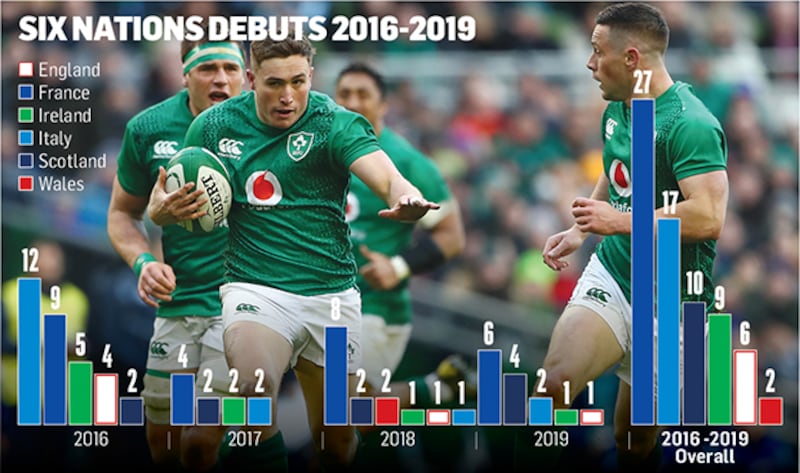CJ Stander, Ultan Dillane, Stuart McCloskey, Josh van der Flier, Finlay Bealham, Niall Scannell, Andrew Conway, Jordan Larmour and Jack Carty share a common bond in the context of the Ireland rugby team in that all made their respective debuts in the Six Nations Championships between 2016 and 2019.
Across four campaigns, from the first Six Nations after the 2015 World Cup to the last before the global tournament in Japan last year, the then Ireland head coach Joe Schmidt brought in nine new faces. Five, or 44 per cent, of Ireland's total debutants in the period under review were introduced in the 2016 Six Nations, as the countries began a four-year cycle to the global tournament in Japan.
It was a common trend as Italy shook up its test match base with 12 players (70 per cent) awarded first caps in 2016 under the outgoing coach Jacques Brunel. Conor O'Shea took over as head coach in late March of that year and only added five more new faces. The new Azzurri boss, South African Franco Smith has just three uncapped players in his 35-man squad so continuity in personnel appears to be the short-term objective.
France too were under new management, Guy Noves, belatedly getting a shot at the national job after masterminding Toulouse's great years in Europe and he put his imprimatur on the squad by introducing nine players (33 per cent of the total), although the French never tired of freshening up the playing group throughout the four years.
Even Brunel, returning to test match coaching when appointed the new French coach following Noves' sacking in December 2017, continued the French predilection to tinker and tweak. In the four seasons under scrutiny, Noves, in charge for two, gave 13 players a debut, Brunel, 14. That is unlikely to change in the short term as new coach Fabien Galthie named 19 uncapped players in a 42-man squad ahead of the upcoming Six Nations.
New Zealander Vern Cotter was in charge of Scotland in 2016 and 2017, during which he turned to four new faces during those Six Nations before the current coach Gregor Townsend took over in June 2017; his tally stands at six and counting given that he's half a dozen uncapped players in a 38-man squad.
Eddie Jones succeeded Leinster's Stuart Lancaster as England coach after the 2015 World Cup and the Australian used up 66 per cent (four) of the six debuts he's handed out in that first season; Maro Itoje, Elliot Daly, Paul Hill and Jack Clifford in a tournament in which the English won the Grand Slam. In the next three seasons only Exeter Chiefs prop Alec Hepburn (2018) and Wasps scrumhalf Dan Robson (2019) made their England bows in the Six Nations.

Warren Gatland earned and deserved his reputation of giving young Welsh players a chance at test level but as the graphic illustrates, that did not extend to the Six Nations during this period. In three of the four seasons, in 15 of the 20 matches, the Welsh team didn't contain a new cap, the exception being the 2018 championship when wing Josh Adams won his first cap against Scotland and flanker James Davies did likewise against Italy.
So what – if any – correlation can be drawn from the breakdown of debutants? The short answer is nothing in straight-line thinking. England won a Grand Slam in 2016 (four new faces), Ireland emulated that feat in 2018 (one new cap, Jordan Larmour), while Wales also managed it last season (none). France’s scattergun approach didn’t work while Italy, 2016 apart, was quite parsimonious in rotating new players in.
Experiment
Scotland, Ireland, England and in particular Wales, preferred to experiment personnel-wise on summer tours or during the November test series when the bulk of new caps were handed out, a state of affairs that might not change appreciably in the current Six Nations or at least in the opening couple of rounds. The honourable exception is France whose squad bears a youthful look with a smattering drawn from the last two Under-20 World Cup winning teams.
Galthie initially selected 19 uncapped players in his 42-man squad, England eight (34), Scotland six (38), Wales, now under Wayne PIvac contains five (38), Ireland with head coach Andy Farrell at the helm, five (36) – Ireland have the most players aged 30 or over (nine) – and Italy, three (35).
Results and injuries over the next two months will have a significant bearing on whether opportunity knocks for those hoping to win a first cap in the Six Nations. The year after a World Cup, and especially with four new coaches at the helm, suggests that this tournament may offer up more than the next three seasons.












